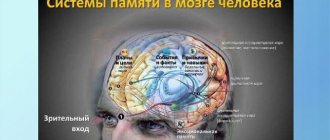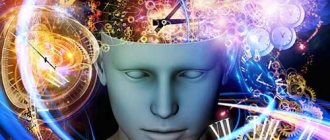Volume is the number of objects that a person is able to grasp simultaneously (V=5±2 units)
The study of attention span is usually carried out by analyzing the number of simultaneously presented elements (numbers, letters, etc.) that can be clearly perceived by the subject. For these purposes, a tachistoscope is used - a device that makes it possible to present a certain number of stimuli so quickly that the subject cannot move his eyes from one object to another. This allows you to measure the number of objects available for simultaneous identification. Typically, a tachistoscope consists of a window separated from the object in question by a falling screen, the slot of which can be arbitrarily changed so that the object in question appears in it for a very short period of time (from 10 to 50-100 ms.). An indicator of the volume of attention is the number of clearly perceived objects. Attention span is a variable that varies individually, but usually its indicator in people is 5±2.
Stability is the duration of concentration of consciousness on an object.
It has now been proven that the most essential condition for the stability of attention is the ability to reveal new aspects and connections in the subject on which it is focused. When the task at hand requires us to concentrate on any subject, and we discover new aspects in it in their relationships and mutual transitions, attention can remain stable for a very long time. In cases where the content of a subject does not provide an opportunity for further study, we are easily distracted and our attention fluctuates. In other words, to maintain attention to any object, it is necessary that the perception of the object develops and reveals new content to us.
Concentration is the degree and intensity of concentration on an object.
Distribution is the ability to hold a certain number of heterogeneous objects in the center of attention.
Distribution of attention refers to a person’s ability to perform several types of activities simultaneously.
The distribution of attention is the reverse side of its other property - switchability.
Switchability is the ability to deliberately quickly move from one object of attention to another.
Switching means a conscious and meaningful movement of attention from one object to another. In general, switching attention means the ability to quickly navigate a complex, changing situation. The ease of switching attention varies from person to person and depends on a number of conditions (primarily on the relationship between previous and subsequent activities and the subject’s attitude towards each of them). The more interesting the activity, the easier it is to switch to it. It should be noted that switching attention is one of the well-trained qualities.
Selectivity is the ability to successfully tune in to perceive information in the presence of interference.
Also distinguished are such properties as:
Distractibility is the involuntary movement of attention from one object to another. The causes of distractibility can be external or internal.
It occurs when extraneous stimuli act on a person who is engaged in some activity at that moment.
Distractibility can be external or internal.
External distractibility occurs under the influence of external stimuli. The most distracting objects or phenomena are those that appear suddenly and act with varying strength and frequency. In response to these stimuli, a person develops a difficult-to-extinguish orienting reflex
Internal distraction of attention occurs under the influence of strong experiences, extraneous emotions, due to a lack of interest and a sense of responsibility that has affected the person who is currently occupied.
Absent -mindedness is the inability to concentrate on anything specific for a long time.
There are:
Genuine absent-mindedness - may occur in young children; in adults - for physiological reasons.
Imaginary absent-mindedness is a person’s inattention to surrounding objects, caused by extreme concentration on one’s thoughts, some object, or phenomenon.
Cognitive processes
Cognitive processes are mental processes that ensure the receipt, storage and reproduction of information and knowledge from the environment.
We can say that when they talk about abilities, talent, genius, intelligence and level of development, they mean, first of all, cognitive processes. A person is born with these inclinations, but at the beginning of life he uses them unconsciously; later their formation occurs. If he learns to use them correctly, and most importantly, to develop them, he will be able to achieve the most ambitious goals.
There are different classifications of cognitive processes, most often there are eight of them. Brief description of them:
- Memory : This is the system of remembering, forgetting and recalling experiences over time. In the psychology of cognitive processes, memory ensures the integrity of the individual.
- Attention : this is the selective direction of perception towards something. At the same time, attention is not considered a separate cognitive process, but rather a property of the others.
- Perception : sensory knowledge of objects in the surrounding world, subjectively appearing direct, immediate. It is very closely related to sensations, through which information is received by the brain and is material for processing, evaluation and interpretation by perception.
- Thinking : this is the ability to obtain certain knowledge about phenomena that cannot be perceived through other cognitive processes. It can be verbal-logical, visual-entrepreneurial, practical, visual-figurative.
- Imagination : a person’s ability to spontaneously arise or deliberately construct images, ideas, ideas of objects in the mind. It is the basis of visual-figurative thinking.
- Speech : a process of communication that occurs through language. A person is capable of perceiving and accepting linguistic structures, creating and reproducing his thoughts using language.
- Representation : the ability to reflect in consciousness the quality of various objects. There are speech, phonetic, auditory, intonation, musical and visual representations.
- Sensations : a person’s ability to feel specific phenomena and objects around him. Our consciousness, one might say, exists only thanks to them. There are gustatory, visual, olfactory, auditory and tactile sensations (however, some scientists believe that these are only basic; there are also additional ones). Information obtained through sensations (sense organs) is transmitted to the brain and perception comes into play.
On our website you can find a lot of materials devoted to the theory and training of various cognitive processes:
- A course on memory development (also develops attention).
- Creative thinking course (trains imagination, memory and presentation).
- Cognitive science (trains thinking).
Diagnostics of cognitive processes in adults and children
In psychiatry, there are a huge number of tests and techniques that diagnose cognitive processes.
Children's tests can be divided by age:
- From 3 to 6.
- From 7 to 16.
Tests for schoolchildren from 3 to 6 years old:
- “Cut out the shapes.” For psychodiagnostics of visual-effective thinking.
- “Remember and dot the points.” Attention span.
- “Who lacks what?” For psychodiagnostics of children's thinking.
- "Find the sound." To test phonemic hearing.
- "Divide into groups." To diagnose figurative-logical thinking.
Tests for children from 7 to 16 years old:
- "20 words." To assess the development of memorization techniques.
- "Comparison of Concepts". To assess the ability to carry out analytical and synthetic activities.
Tests for adults:
- "Anagrams - 2011. Form A." To identify the level of fluency of abstract logical thinking and combinatorial abilities.
- “Learning words according to A. R. Luria.” To study memory processes.
- "Quantitative Relations". To assess logical thinking.
- "Munstenberg test". Noise immunity and selectivity of attention.
Whatever the level of your cognitive processes, you must train them, and ideally this should be done constantly.
Let's focus on each cognitive process and find out what games and exercises there are to develop it. Of course, it is impossible to fully cover the topic in the space of a blog article, so this is just basic information.
1
Memory
Exercise one : memorizing words.
Read the following list: drum, chair, carpet, letter, cork, tool, pan, picture, vase, pin, bag. Take 30 seconds to memorize them. Don't try to use mnemonics.
Exercise two : remember yesterday.
Our memory deteriorates because we very rarely try to remember past events and do not keep a diary. So sit in a quiet place and try to recreate yesterday in the smallest detail.
Exercise three : kitchen.
Right now, try to remember what your kitchen (or any other room you know well) looks like in detail.
2
Attention
Exercise one : Stroop test.
Look at the picture and name the colors in which each word is written.
Exercise two : radio.
Play a song that has a lot of words. After 10 seconds, begin to gradually reduce the volume. Set the lowest limit at which you can still understand what is being said. Start listening to this song again. This exercise will allow you to focus only on her.
Exercise three : observation.
Find an image of an unknown painting on the Internet. Look at it for one minute. Close your eyes and try to reproduce it exactly. Open your eyes and compare the results.
3
Perception
Exercise : overcoming noise (selectivity of perception).
This exercise will require at least four people to participate. The members of each pair are placed from each other at the maximum possible distance (in the corners of the room). After that, everyone starts talking at the same time. The task of each participant is to carry on a dialogue with his partner, despite the noise.
4
Thinking
Exercise one : brain box.
Choose any three topics. This could be the plot of a recently watched film, an idea, news. Now start thinking about the first topic for three minutes. When finished, move on to the second topic, then to the third.
Exercise two : find the reason.
The exercise must be done in company. One person performs an action for a reason known only to him, and the second participant must guess it. And so on until all the motives for the behavior of the first participant are clarified.
5
Imagination
Exercise one : random words.
Pick ten random words from a book or magazine. Link them together to make a short story, interspersing them with other words.
Exercise two : idea from chaos.
Take a sheet of paper and randomly place several dots on it. Connect them with lines. What associations does the figure evoke? What does she look like? The same game can be played by two people. One draws, the other guesses and vice versa.
6
Speech
These exercises are suitable for children from 2 to 6 years old.
Exercise one : words starting with a specific letter.
Ask your child to name as many words as possible that start with a specific letter.
Exercise two : searching for verbs.
Choose nouns for your child ("house", "road", "car") and let him choose verbs for them. For example, a car drives, brakes, turns, stops, accelerates.
Exercise three : retelling what you read.
Choose a story that is likely to interest your child. Read it. Now invite him to retell the text, ask clarifying questions.
7
Performance
To form and develop spatial understanding, we recommend that you collect puzzles and play with Lego as much as possible. This activity is useful for both a child and not shameful for an adult.
8
Feel
Exercise one : observing a tree (visual sensations).
Look out the window and watch a tree or any other large object. Appreciate its height, beauty, colors. Compare with other trees.
Exercise two : comparing sounds.
Go out onto the balcony again and listen to the sounds. Choose the two that are the most intense and loud. Start comparing.
Exercise three : taste sensations.
If you have two types of cheese or other product, cut it into small pieces and try one at a time. What is the difference? Find 5 differences.
We wish you good luck!
Did you like the article? Join our communities on social networks or our Telegram channel and don’t miss the release of new useful materials: TelegramVKontakteFacebook
We also recommend reading:
- Storytelling
- Mental processes: types and brief description
- Intelligence and its development: several recommendations
- Cattell-Horn-Carroll theory
- Exercises for memory development in preschoolers
- Neuroplasticity
- Two important laws of memory
- Language and thinking
- Cognitive psychology and cognitive psychotherapy
- Cognitive sphere of personality
- Development of thinking: ways to train the brain
Key words: _D1002, _D1003, _D1026, _D1027, 1Mnemotechnics, 4Cognitive science
Attention disorders
- Absent is a phenomenon in which a person is unable to concentrate on something for a long time.
- Mobility of attention is a phenomenon in which a person quickly switches attention from one action to another. The effect of these actions is low.
- Inertia of attention is a phenomenon when a person has a pathological fixation of attention on a limited number of thoughts.
- Aprosexia is a phenomenon when a person lacks attention.
As you can see, attention is a complex multifaceted process that helps a person carry out any activity.
What are the mental processes
Are you an expert in this subject area? We invite you to become the author of the Directory Working Conditions
Today, psychological processes are divided into separate subgroups conditionally, since in modern psychology it is no longer customary to distinguish between them. This is explained by the fact that some mental processes are impossible without others, for example, attention is impossible without thinking.
All mental processes are conventionally divided into:
- educational
- emotional
- strong-willed
Cognitive mental processes include:
- Feel
- reflection
- speech
- perception
- performance
- attention
- thinking
- memory
- imagination
Emotional mental processes include:
- emotions
- affects
- stress
- feelings
Volitional mental processes are divided into:
- goal setting
- decision-making
- struggle of motives
This article will examine in more detail such a cognitive mental process as attention.
Properties of attention
Attention has the following properties:
- Sustainability of attention The ability of a person to concentrate attention on something specific, for example, to reveal new phenomena of the subject.
- Concentration of attention The ability of a person to be carried away by something specifically, without being distracted by other stimuli.
- Attention span refers to the number of objects that one person can take into account.
- Distribution of attention The ability of a person to keep several objects in his attention at once.
- Switching attention A person’s ability to shift attention from one subject to another.
What are mental processes
Note 1
The concept of “mental processes” is one of the key ones in psychology. This term refers to the processes of human mental activity that have special functions in the holistic structure of the psyche.
Mental processes have a number of specific characteristics, such as:
- short-term
- fast flowing
- are a response to what is happening
- closely related
Mental processes merging together form the psyche of the individual. The psyche is constantly changing under the influence of the surrounding reality. The study of the psyche always occurs in dynamics, in the process of interaction. Mental processes are also studied in dynamics.
Features of the formation of cognitive processes in preschool children
The development of cognitive processes in preschool age occurs in stages. The formation of types, functions, operations of each process of cognition first overcomes the stage of involuntariness.
Younger preschoolers learn about the world involuntarily. They pay attention, perceive and remember only what interests and attracts them.
Since a 3-4 year old child is busy with objective activities, his thinking is also directed only at objects that arouse curiosity.
The main task in the development of cognitive processes is to form the property of arbitrariness. The child must learn to control the functions of cognition and comprehend not only what attracts with its brightness or sonority. The world around us is filled with a variety of objects, phenomena, properties, events, relationships - we have to comprehend them all.
It is possible to get used to and develop in this world only under the condition of purposeful cognition using volitional efforts. This is the arbitrary nature of cognitive processes.
By the time he enters school, along with involuntary perception and attention, it is important for a preschooler to be able to voluntarily use cognitive functions. Elements of voluntariness are laid down on the basis of speech development and such properties as cognitive interest and curiosity.











